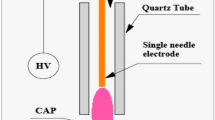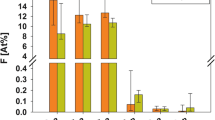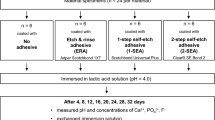Abstract
TOOTH sections have been bombarded with a 5-kV argon ion beam inside the specimen chamber of a scanning electron microscope. This apparatus was designed so that the ion beam could be focused into a 1.5-mm diameter spot on the surface of the specimen, covering the area viewed by the microscope. The ions were extracted from a radio-frequency ion source and were focused by two electrostatic lenses on to the specimen, through two apertures. The pressure in the specimen chamber when the ion source was running was better than 10−6 mm mercury. The ion beam density was not uniform over its cross-section, but varied from about 10 m. amp/cm2 at the centre to zero at the edge; this enabled us to check that, for the current densities we utilized, the nature of the changes in the specimen surface that was produced was not a function of the rate of etching. The bombarded area was kept to a minimum to reduce the amount of material deposited on the electron collection system, and reduce the temperature rise, which we have calculated to be less than 100° C, using the values of thermal conductivity given by Craig and Peyton1. The total ion current was kept to about 15µ amp. The micrographs were taken with a 16-kV scanning electron beam and only the high-energy reflected electrons were used to form the picture. This allowed micrographs to be taken with a resolution better than 500 Å., even though the specimen tended to charge under the electron beam. This method of observation also allows pictures to be taken while the surface is under bombardment; but for this work it was found preferable alternately to bombard for, say, 5 min, and then observe the surface at leisure. The ion beam made an angle of about 40° to the specimen normal: the direction is indicated by the arrow on the micrographs. The surface was also viewed at an oblique angle, as is indicated by the magnification symbols on the micrographs (Figs. 1 and 2).
This is a preview of subscription content, access via your institution
Access options
Subscribe to this journal
Receive 51 print issues and online access
$199.00 per year
only $3.90 per issue
Buy this article
- Purchase on Springer Link
- Instant access to full article PDF
Prices may be subject to local taxes which are calculated during checkout
Similar content being viewed by others
References
Craig, R. C., and Peyton, F. A., J. Dent. Res., 40, 411 (1961).
Helmcke, J. G., Schulz, L., and Scott, D. B., J. Dent. Res., 40, 668 (abst.) (1961); and personal communication from J. G. Helmcke.
Author information
Authors and Affiliations
Rights and permissions
About this article
Cite this article
STEWART, A., BOYDE, A. Ion Etching of Dental Tissues in a Scanning Electron Microscope. Nature 196, 81–82 (1962). https://doi.org/10.1038/196081a0
Issue Date:
DOI: https://doi.org/10.1038/196081a0
This article is cited by
-
Transmission electron microscopy of ion erosion thinned hard tissues
Calcified Tissue Research (1975)
-
Scanning electron microscopic studies of cilia
Zeitschrift f�r Zellforschung und Mikroskopische Anatomie (1967)
Comments
By submitting a comment you agree to abide by our Terms and Community Guidelines. If you find something abusive or that does not comply with our terms or guidelines please flag it as inappropriate.



